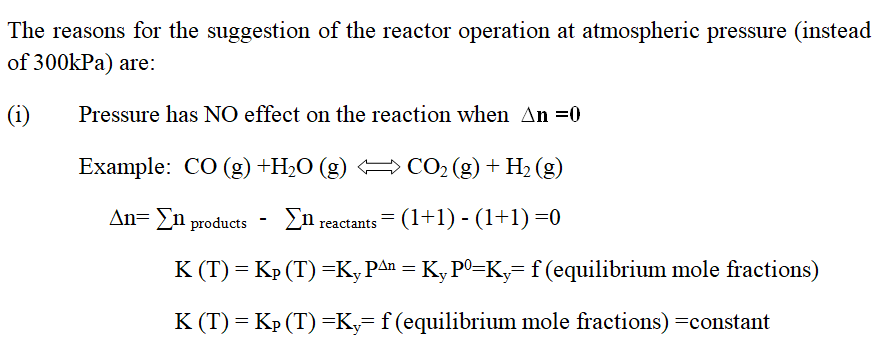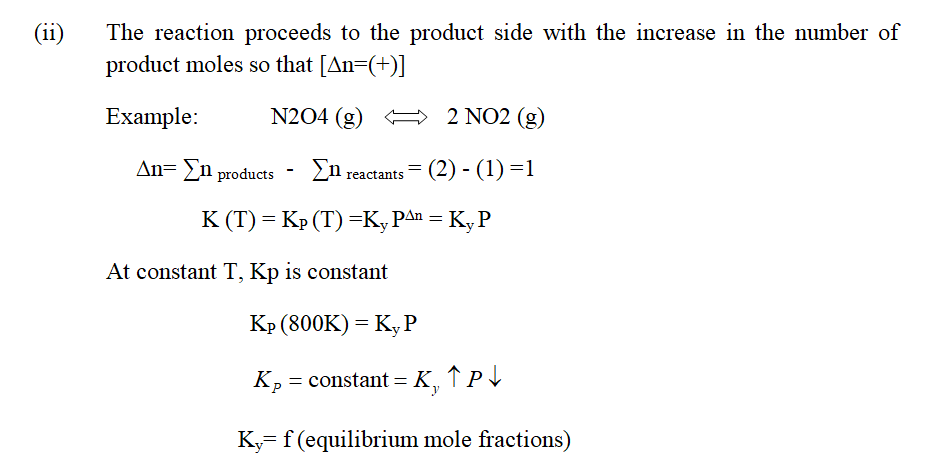a) The new engineer you hired suggests operating the reactor at atmospheric pressure (instead of 300 kPa) while keeping the temperature constant (at 800 K) to increase the conversion to product “C”. Would decreasing the pressure increase the conversion? Why? b) Would you consider using an inert gas (such as argon) while keeping the T and the P constant to increase the conversion? Why? c) Is this reaction endothermic or exothermic? List two benefits of operating the reactor at 800 K? Explain with reactions please
a) The new engineer you hired suggests operating the reactor at atmospheric pressure (instead of 300 kPa) while keeping the temperature constant (at 800 K) to increase the conversion to product “C”. Would decreasing the pressure increase the conversion? Why? b) Would you consider using an inert gas (such as argon) while keeping the T and the P constant to increase the conversion? Why? c) Is this reaction endothermic or exothermic? List two benefits of operating the reactor at 800 K? Explain with reactions please
Introduction to Chemical Engineering Thermodynamics
8th Edition
ISBN:9781259696527
Author:J.M. Smith Termodinamica en ingenieria quimica, Hendrick C Van Ness, Michael Abbott, Mark Swihart
Publisher:J.M. Smith Termodinamica en ingenieria quimica, Hendrick C Van Ness, Michael Abbott, Mark Swihart
Chapter1: Introduction
Section: Chapter Questions
Problem 1.1P
Related questions
Question
a) The new engineer you hired suggests operating the reactor at atmospheric pressure (instead of 300
kPa) while keeping the temperature constant (at 800 K) to increase the conversion to product “C”.
Would decreasing the pressure increase the conversion? Why?
b) Would you consider using an inert gas (such as argon) while keeping the T and the P constant to
increase the conversion? Why?
c) Is this reaction endothermic or exothermic? List two benefits of operating the reactor at 800 K?
Explain with reactions please
Expert Solution
Introduction


(a) Effect of pressure on the equilibrium conversion



Step by step
Solved in 4 steps with 9 images

Knowledge Booster
Learn more about
Need a deep-dive on the concept behind this application? Look no further. Learn more about this topic, chemical-engineering and related others by exploring similar questions and additional content below.Recommended textbooks for you

Introduction to Chemical Engineering Thermodynami…
Chemical Engineering
ISBN:
9781259696527
Author:
J.M. Smith Termodinamica en ingenieria quimica, Hendrick C Van Ness, Michael Abbott, Mark Swihart
Publisher:
McGraw-Hill Education

Elementary Principles of Chemical Processes, Bind…
Chemical Engineering
ISBN:
9781118431221
Author:
Richard M. Felder, Ronald W. Rousseau, Lisa G. Bullard
Publisher:
WILEY

Elements of Chemical Reaction Engineering (5th Ed…
Chemical Engineering
ISBN:
9780133887518
Author:
H. Scott Fogler
Publisher:
Prentice Hall

Introduction to Chemical Engineering Thermodynami…
Chemical Engineering
ISBN:
9781259696527
Author:
J.M. Smith Termodinamica en ingenieria quimica, Hendrick C Van Ness, Michael Abbott, Mark Swihart
Publisher:
McGraw-Hill Education

Elementary Principles of Chemical Processes, Bind…
Chemical Engineering
ISBN:
9781118431221
Author:
Richard M. Felder, Ronald W. Rousseau, Lisa G. Bullard
Publisher:
WILEY

Elements of Chemical Reaction Engineering (5th Ed…
Chemical Engineering
ISBN:
9780133887518
Author:
H. Scott Fogler
Publisher:
Prentice Hall


Industrial Plastics: Theory and Applications
Chemical Engineering
ISBN:
9781285061238
Author:
Lokensgard, Erik
Publisher:
Delmar Cengage Learning

Unit Operations of Chemical Engineering
Chemical Engineering
ISBN:
9780072848236
Author:
Warren McCabe, Julian C. Smith, Peter Harriott
Publisher:
McGraw-Hill Companies, The